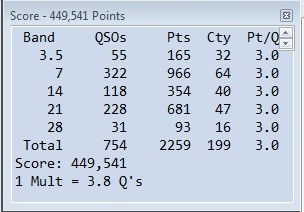 The North American QSO party contests are unique events in that they do not allow high power entries. All stations must run 100 watts or less; putting more importance on the antenna and receiving systems.
The North American QSO party contests are unique events in that they do not allow high power entries. All stations must run 100 watts or less; putting more importance on the antenna and receiving systems. Last month I participated in the CW & SSB NAQP events running my FT-1000mp portable from W7AYT. A couple of weekends back I ran the WPX RTTY contest remotely from NX6T in Fallbrook putting a 550 watt signal on the air.
For NAQP RTTY this weekend I setup another remote operation from NX6T. Because NAQP
max power is 100 watts and RTTY is considered
a full-duty cycle mode which can put a lot of strain on most radios, setting the k3 output power down to 4 watts and driving the ACOM 2000a amplifier to ~ 99 watts seemed to solve that problem; until the IP-remote control of the amplifier failed.
Without amplifier control I bypassed the amp and set the power to ~ 60 watts. Unfortunately I forgot
to up the power for 80 meters and made the 1st 9 QSOs running only 4 watts - Oops. Nevertheless calling CQ on 3575.75, I received calls from: N0NI, NV9L, VE7FO, K9GWS, N7MDS & WB6JJJ - go figure. When I jumped the power to 62 watts several receiver front-ends probably received quite a BLAST.
 |
| (Left) 2-EL on 40 & 80-m Inv Vee (Right) C-31 Yagi --- both @ 13mh |
I set about discovering what the problem really was. Because single-OPs are only allowed to operate 10 out of the 12 contest hours, this became my first off hour. Suddenly, the antenna problem was resolved and WQ6X fired-up on 21104.04.
The last several contest weekends have happened amidst poor space weather conditions. This weekend, while the predictions were more favorable, for NAQP 10 meters was non-existent with 20 & 15 being a toss-up for best band. Outside of one VK5 station on 20 (who called me off the back of the C-31 yagi), there were no QSOs outside of U.S. and Canada; no Central/South America, no EU and no JA - HuH?
The DX-Map spotting facility spotted WQ6X being heard in Japan
and yet there was no one there to work me - Bummer Dewd!
 |
| WQ6X spotted by 7L4IOU |
On the plus side, I liked the creative use of names such as: BIGFRANK, HILLTOP, DOYLE, CJ & JERZY (who was actually in NY).
Because this was a remote operation I chose to run frequencies 99% of the time. Unfortunately, many stations would call me OFF FREQUENCY and then get mad when I told them to tune me in rather than using RIT (which is not possible to do using the RCForb software to run the K3).
So, instead of getting MAD at me or calling me LAZY (as one station did), the REAL solution is to BE ON FREQUENCY WHEN YOU CALL ME - HELLO!.......
If you can read my message saying your are off frequency, then synch your VFOs before calling me. If you cannot read that message then you ARE off frequency and need to tune me in. My message to these idiots is: "What part about being on frequency before making a radio transmission do you NOT understand?"
During the last hour while running on 3575.75
at 04:30z I got preempted by the RN6 CW traffic net so I setup camp on 3592.92. Unfortunately, stations seemed to have trouble finding me after that so I made the final 3 QSOs on 7.100.
To wrap the weekend, on Sunday while capturing the NAQP log, I remembered the North Carolina QSO party (NAQP) was also happening so I spent the final hour of the NCQP picking off a dozen NC stations on 20 and then 40 meters. I was amazed that I could even be heard on 40 at 00:30z.
Did you play in the NAQP RTTY contest?
Is WQ6X in YOUR log?



















